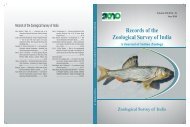Vol. 111 - Part I - Zoological Survey of India
Vol. 111 - Part I - Zoological Survey of India
Vol. 111 - Part I - Zoological Survey of India
You also want an ePaper? Increase the reach of your titles
YUMPU automatically turns print PDFs into web optimized ePapers that Google loves.
SAMBATH : Studies on the sphingid Fauna <strong>of</strong> Dalma Wildlife Sanctuary, Jharkhand 27<br />
black patch at anal angle. Rainy season specimens are<br />
usually dark.<br />
Material Examined : 1 ex., 5.viii.2008; 1 ex.,<br />
6.viii.2008; Pindra pera, Dalma wildlife sanctuary, East<br />
Singhbhum, Jharkhand, coll. S. Sambath & <strong>Part</strong>y.<br />
Wingspan : 82-138 mm.<br />
Occurrence : August to December.<br />
Distribution : <strong>India</strong> : Jharkhand (East Singhbhum),<br />
Orissa (Keonjhar) Madhya Pradesh (Seoni, Sidhi,<br />
Umaria), West Bengal and rest <strong>of</strong> the mainland.<br />
Elsewhere : China and eastwards to the Solomon<br />
Islands.<br />
Host Plants : Clerodendron infortunatum, Tectona<br />
grandis, Vitex negundo.<br />
Subfamily AMBULICINAE<br />
Genus Polyptychus Hubner<br />
6. Polyptychus dentatus (Cramer)<br />
1777. Sphinx dentatus Cramer, Pap. Exot., 2 : 42.<br />
1937. Polyptychus dentatus, Bell & Scott, Fauna Brit. <strong>India</strong>,<br />
Moths, 5 : 169.<br />
Diagnosis : Whitish-cinereous. The post-discal and<br />
discal lines <strong>of</strong> fore wing parallel, straight, the former<br />
not curved dista beyond R2; the dendate line between<br />
them distinct.<br />
Material Examined : 1 ex., 27.ix.2008, Pindra pera,<br />
Dalma wildlife sanctuary, East Singhbhum, Jharkhand,<br />
coll. S. Sambath & <strong>Part</strong>y.<br />
Wingspan : 110 mm.<br />
Occurrence : September-December.<br />
Distribution : <strong>India</strong> : Jharkhand East Singhbhum),<br />
Madhya Pradesh (Indore, Seoni), West Bengal, Eastern<br />
and Northwest Himalaya, Maharashtra (Bombay),<br />
Southern peninsula and Uttar Pradesh (Allahabad).<br />
Elsewhere : China, Pakistan and Sri Lanka.<br />
Host Plants : Cordia oblique.<br />
Genus Oxyambulyx Rothschild & Jordan<br />
7. Oxyambulyx subocellata (Feld.)<br />
1874. Ambulyx subocellata Felder, Reise Ost. Fregatte<br />
Novara, Lep. t. 76.<br />
1937. Oxyambulyx subocellata, Bell & Scott, Fauna Brit.<br />
<strong>India</strong>, Moths, 5 : 136.<br />
Diagnosis : Can be distinguished from all others <strong>of</strong><br />
the genus by the thinness <strong>of</strong> the thoracic stripe over<br />
the tegula and by the series <strong>of</strong> subbasal spots on fore<br />
wing upper side. Body reddish brown, thoracic stripe<br />
very thin. The fore wing with a series <strong>of</strong> four subbasal<br />
spots, green edged with white. Hind wing yellow pale<br />
or reddish brown.<br />
Material Examined : 3 exx., 22.viii.2007; 3 exx.,<br />
27.ix.2008, Pindra pera, Dalma wildlife sanctuary, East<br />
Singhbhum, Jharkhand, coll. S. Sambath & <strong>Part</strong>y.<br />
Wingspan : 90-110 mm.<br />
Occurrence : August-September.<br />
Distribution : Adaman Islands, Southern peninsula.<br />
Elsewhere : China (south), Malaya and Sri Lanka.<br />
Host Plants : Odina odier and Buchanania latifoilia.<br />
8. Oxyambulyx substrigilis aglaia Jord.<br />
1923. Oxyambulyx substrigilis aglaia Jordan, Novit. Zool.,<br />
26 (1) : 190-192.<br />
1937. Oxyambulyx substrigilis aglaia, Bell & Scott, Fauna<br />
Brit. <strong>India</strong>, Moths, 5 : 128.<br />
Diagnosis : This species is easily distinguished by<br />
the large black or tawny basal patch <strong>of</strong> hind wing upper<br />
side. Dorsal line <strong>of</strong> abdomen distinct.<br />
Material examined : 5 exx., 27.ix.2008, Pindra pera,<br />
Dalma wildlife sanctuary, East Singhbhum, Jharkhand,<br />
coll. S. Sambath & <strong>Part</strong>y.<br />
Wingspan : 105-120 mm.<br />
Occurrence : September-October.<br />
Distribution : Southern <strong>Part</strong> <strong>of</strong> <strong>India</strong>.<br />
Host Plants : Algaia littoralis.<br />
DIVISION-SEMANOPHORAE<br />
Subfamily PHILAMPELINAE<br />
Tribe NEPHELINI<br />
Genus Acosmeryx Boisduval<br />
9. Acosmeryx anceus subdentata<br />
Rothschild & Jordan.<br />
1903. Acosmeryx anceus subdentata Rothschild & Jordon,<br />
Revision <strong>of</strong> Sphingidae, p. 528.<br />
1937. Acosmeryx anceus subdentata, Bell & Scott, Fauna<br />
Brit. <strong>India</strong>, Moths, 5 : 294.<br />
Diagnosis : The smallest species <strong>of</strong> the genus, and<br />
markings different from those <strong>of</strong> all the other species.<br />
Fore wing distinctly angulate at R3 , <strong>of</strong>ten with traces<br />
<strong>of</strong> teeth. Upper side tawny cinnamon to chestnutbrown;<br />
an oblique distal band diffuse posteriorly. Hind<br />
wing fuscous.
















